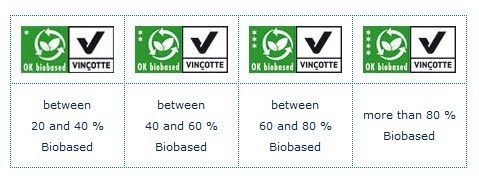Vinçotte Requires Carbon 14 Analysis for OK Biobased Certification
 Belgian inspection, testing, and certification body Vinçotte has launched the OK Biobased eco-label to help manufacturers of biobased products inform consumers that their goods are from biologically renewable sources. Products eligible for the OK biobased eco-label include those made, wholly or in part, from materials of natural origin. Applicants are required to submit carbon 14 analysis results of their products as proof of biobased content.
Belgian inspection, testing, and certification body Vinçotte has launched the OK Biobased eco-label to help manufacturers of biobased products inform consumers that their goods are from biologically renewable sources. Products eligible for the OK biobased eco-label include those made, wholly or in part, from materials of natural origin. Applicants are required to submit carbon 14 analysis results of their products as proof of biobased content.
Products eligible for this Vinçotte eco-label exclude solid, liquid, or gaseous fuels. The OK Biobased eco-label is applicable to raw materials, intermediates, additives, and finished products. An OK Biobased certificate is valid for 3 years.
UPDATE: OK Biobased is now under TÜV AUSTRIA Group
Biobased Content Measurement via Carbon Dating
Popularly known as an archaeological tool, radiocarbon dating can also be used to measure the biobased content of a material. A standard method called ASTM D6866 was developed precisely for this application. A product’s biobased content depends on how much renewable carbon or carbon 14 is present in it. Materials that came from renewable sources have well-characterized levels of carbon 14 in them whereas those of fossil origin no longer have carbon 14. Thus, an ASTM D6866 result is easily correlated to a product’s biobased content.
OK Biobased Star System
The OK Biobased logo features stars to indicate a product’s biobased content – the more stars, the higher the content that came from renewable sources. A product with a logo having one star has a biobased content between 20% and 40%, two stars if between 40% and 60%, three stars if between 60% and 80%, and four stars if more than 80%.
 Products must have at least 30% organic carbon and be at least 20% biobased to carry the logo. Biobased content measurement is done via ASTM D6866, and organic carbon fraction is measured according to Vinçotte’s TS-OK20.
Products must have at least 30% organic carbon and be at least 20% biobased to carry the logo. Biobased content measurement is done via ASTM D6866, and organic carbon fraction is measured according to Vinçotte’s TS-OK20.
This entry was posted on Friday, October 16th, 2009 and is filed under Biobased Products .